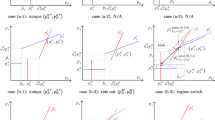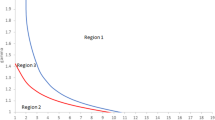Abstract
The existing literature shows that a decrease in the degree of substitutability increases a monopoly’s incentive to bundle. This paper in addition takes into account competition in the second product market and then re-examines how intra-brand and inter-brand product differentiations affect the incentive to bundle. In order to formally examine the above conjectures, this research builds up a two-firm, two-product model in which product 1 (monopoly product) is produced only by the bundling firm and product 2 (competing product) is produced by both firms. The analysis shows that under both Bertrand and Cournot competitions the incentive to bundle does not necessarily increase with the degree of intra-brand differentiation, while it strictly decreases with the degree of inter-brand differentiation. Moreover, under Bertrand competition bundling always decreases consumer surplus, but may increase the competitor’s profit and social surplus. Under Cournot competition bundling always reduces the opponent’s profit and social welfare, but may increase consumer surplus.
Similar content being viewed by others
References
Adams WJ, Yellen JL (1976) Commodity bundling and the burden of monopoly. Q J Econ 90(3): 475–498
Armstrong M, Vickers J (2010) Competitive non-linear pricing and bundling. Rev Econ Stud 77(1): 30–60
Belleflamme P, Peitz M (2010) Industrial organization: markets and strategies. Cambridge University Press, Cambridge
Carbajo J, Meza D, Seidmann DJ (1990) A strategic motivation for commodity bundling. J Ind Econ 38(3): 283–298
Choi JP (2004) Tying and innovation: a dynamic analysis of tying arrangements. Econ J 114(492): 83–101
Christopher V, Brian WH (2010) E-mail management: an exchange 2010 upgrade is worth considering, KM World, vol 19, No 4, pp 12–14. http://www.kmworld.com/Articles/Editorial/Feature/E-mail-managementAn-Exchange-2010-upgrade-is-worth-considering-66059.aspx
Dixit A (1979) A model of duopoly suggesting a theory of entry barriers. Bell J Econ 10(1): 20–32
Economides N (1993) Mixed bundling in duopoly. Discussion Paper EC-93-29, Stern School of Business, New York University
Goto A (2009) Innovation and competition policy. Jpn Econ Rev 60(1): 55–62
Lewbel A (1985) Bundling of substitutes or complements. Int J Ind Organ 3(1): 101–107
Martin S (1999) Strategic and welfare implications of bundling. Econ Lett 62(3): 371–376
Peitz M (2008) Bundling may blockade entry. Int J Ind Organ 26(1): 41–58
Qiu LD (1997) On the dynamic efficiency of Bertrand and Cournot equilibria. J Econ Theory 75(1): 213–229
Romano R, Yildirim H (2005) On the endogeneity of Cournot–Nash and Stackelberg equilibria: games of accumulation. J Econ Theory 120(1): 73–107
Saggi K, Vettas N (2002) On intrabrand and interbrand competition: the strategic role of fees and royalties. Eur Econ Rev 46(1): 189–200
Singh N, Vives X (1984) Price and quantity competition in a differentiated duopoly. RAND J Econ 15(4): 546–554
Sutton J (1997) One smart agent. RAND J Econ 28(4): 605–628
Telser LG (1979) A theory of monopoly of complementary goods. J Business 52(2): 211–230
Venkatesh R, Kamakura W (2003) Optimal bundling and pricing under a monopoly: contrasting complements and substitutes from independently valued products. J Business 76(2): 211–231
Vives X (1985) On the efficiency of Bertrand and Cournot equilibria with product differentiation. J Econ Theory 36(1): 166–175
Whinston MD (1990) Tying, foreclosure, and exclusion. Am Econ Rev 80(4): 837–859
Author information
Authors and Affiliations
Corresponding author
Electronic Supplementary Material
The Below is the Electronic Supplementary Material.
Rights and permissions
About this article
Cite this article
Chung, HL., Lin, YS. & Hu, JL. Bundling strategy and product differentiation. J Econ 108, 207–229 (2013). https://doi.org/10.1007/s00712-012-0265-9
Received:
Accepted:
Published:
Issue Date:
DOI: https://doi.org/10.1007/s00712-012-0265-9




